NVIDIA's GeForce GTX 580: Fermi Refined
by Ryan Smith on November 9, 2010 9:00 AM ESTPower, Temperature, and Noise
Last but not least as always is our look at the power consumption, temperatures, and acoustics of the GTX 580. NVIDIA’s performance improvements were half of the GTX 580 story, and this is the other half.
Starting quickly with voltage, as we only have one card we can’t draw too much from what we know, but there are still some important nuggets. NVIDIA is still using multiple VIDs, so your mileage may vary. What’s clear from the start though is that NVIDIA’s operating voltages compared to the GTX 480 are higher for both idle and load. This is the biggest hint that leakage has been seriously dealt with, as low voltages are a common step to combat leakage. Even with these higher voltages running on a chip similar to GF100, overall power usage is still going to be lower. And on that note, while the voltages have changed the idle clocks have not; idle remains at 50.6MHz for the core.
| GeForce GTX 480/580 Voltages | |||||
| Ref 480 Load | Ref 480 Idle | Ref 580 Load | Ref 580 Idle | ||
| 0.959v | 0.875v | 1.037v | 0.962v | ||
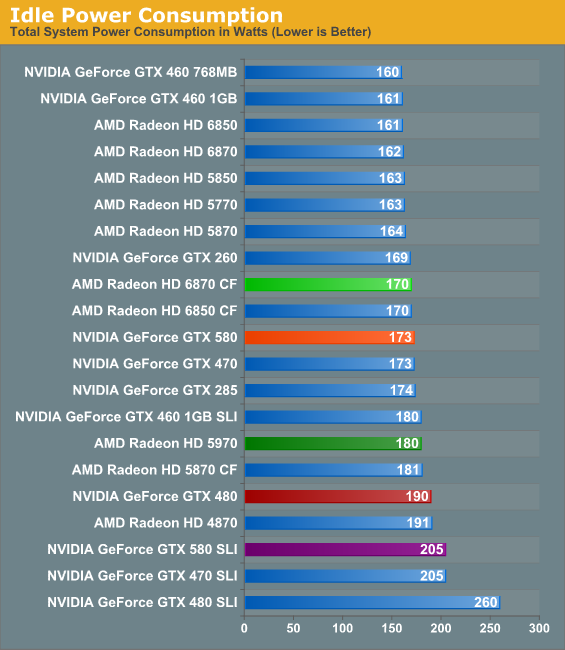
Beginning with idle power, we’re seeing our second biggest sign that NVIDIA has been tweaking things specifically to combat leakage. Idle power consumption has dropped by 17W on our test system even though the idle clocks are the same and the idle voltage higher. NVIDIA doesn’t provide an idle power specification, but based on neighboring cards idle power consumption can’t be far off from 30-35W. Amusingly it still ends up being more than the 6870 CF however, thanks to the combination of AMD’s smaller GPUs and ULPS power saving mode for the slave GPU.
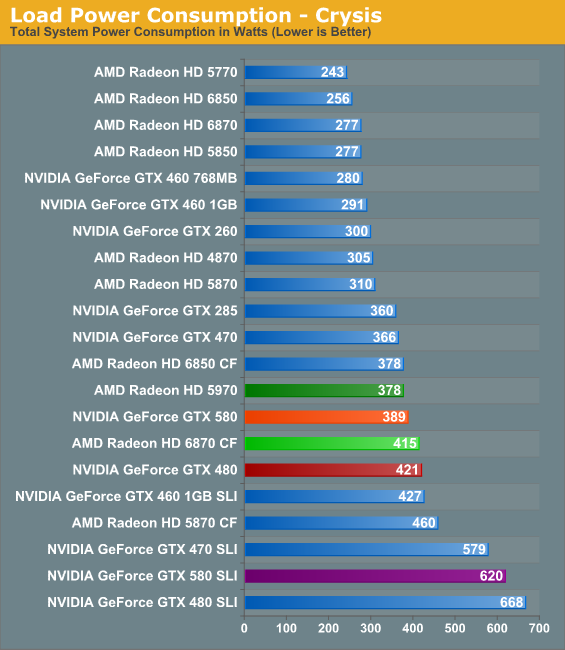
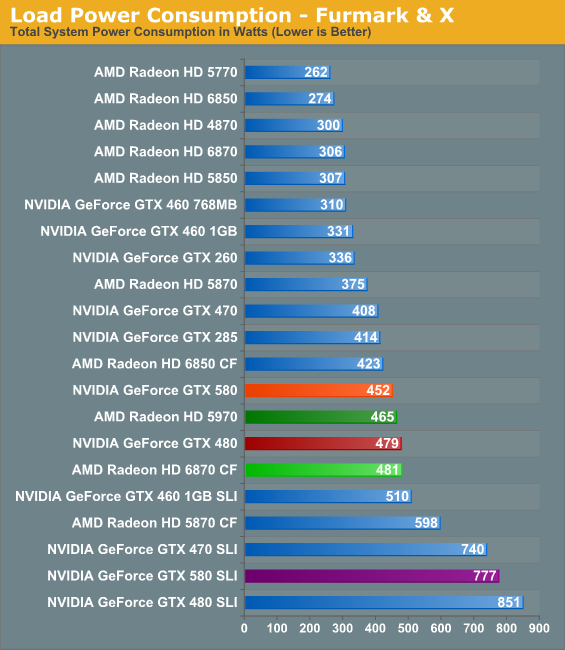
Looking at Crysis, we begin to see the full advantage of NVIDIA’s optimizations and where a single GPU is more advantageous over multiple GPUs. Compared to the GTX 480 NVIDIA’s power consumption is down 10% (never mind the 15% performance improvement), and power consumption comes in under all similar multi-GPU configurations. Interestingly the 5970 still draws less power here, a reminder that we’re still looking at cards near the peak of the PCIe specifications.
As for FurMark, due to NVIDIA’s power throttling we’ve had to get a bit creative. FurMark is throttled to the point where the GTX 580 registers 360W, thanks to a roughly 40% reduction in performance under FurMark. As a result for the GTX 580 we’ve swapped out FurMark for another program that generates a comparable load, Program X. At this point we’re going to decline to name the program, as should NVIDIA throttle it we may be hard pressed to determine if and when this happened.
In any case, under FurMark & X we can see that once again NVIDIA’s power consumption has dropped versus the GTX 480, this time by 27W or around 6%. NVIDIA’s worst case scenario has notably improved, and in the process the GTX 580 is back under the Radeon HD 5970 in terms of power consumption. Thus it goes without saying that while NVIDIA has definitely improved power consumption, the GTX 580 is still a large, power hungry GPU.
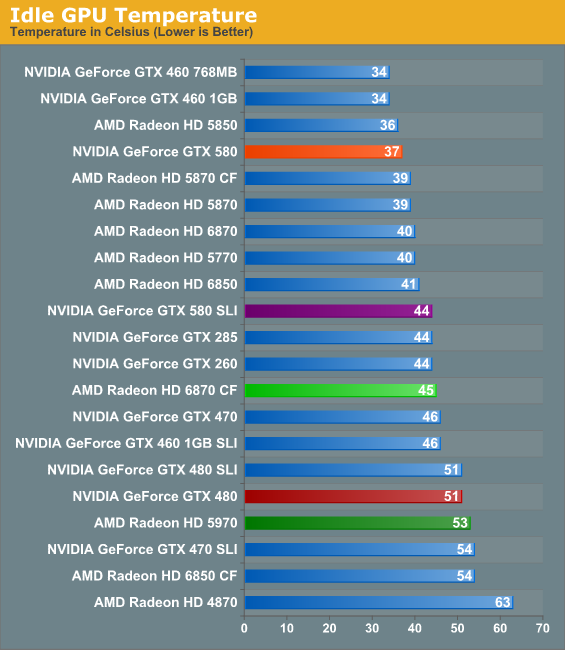
With NVIDIA’s improvements in cooling and in idle power consumption, there’s not a result more dramatic than idle GPU temperatures. The GTX 580 isn’t just cooler, it’s cool period. 37C is one of the best results out of any of our midrange and high-end GPUs, and is a massive departure from the GTX 480 which was at least warm all the time. As we’ll see however, this kind of an idle temperature does come with a small price.
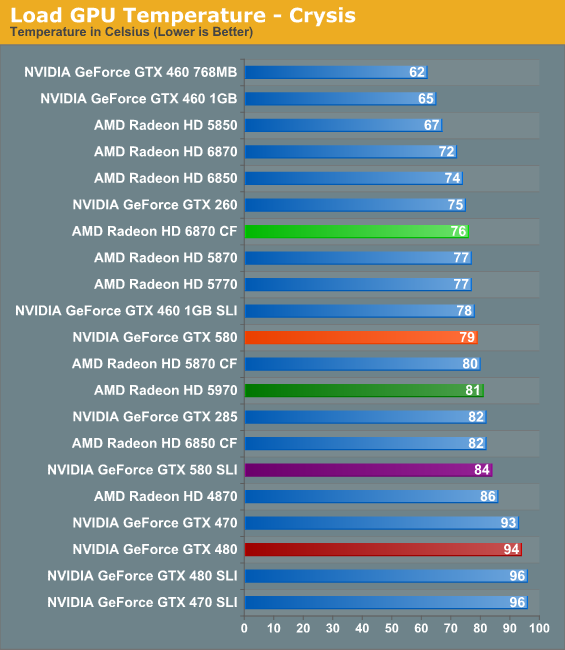
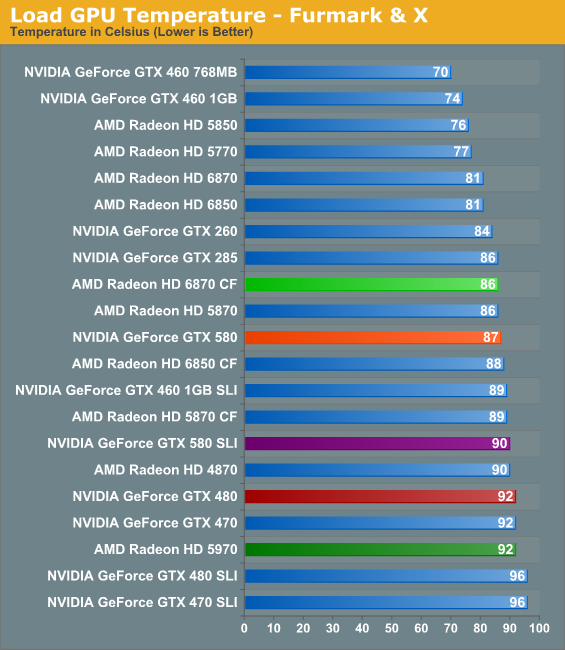
The story under load is much the same as idle: compared to the GTX 480 the GTX 580’s temperatures have dramatically dropped. At 79C it’s in the middle of the pack, beating a number of single and multi GPU setups, and really only losing to mainstream-class GPUs and the 6870 CF. While we’ve always worried about the GTX 480 at its load temperatures, the GTX 580 leaves us with no such concerns.
Meanwhile under FurMark and Program X, the gap has closed, though the GTX 580 remains in the middle of the pack. 87C is certainly toasty, but it’s still well below the thermal threshold and below the point where we’d be worried about it. Interestingly however, the GTX 580 is actually just a bit closer to its thermal threshold than the GTX 480 is; NVIDIA rated the 480 for 105C, while the 580 is rated for 97C. We’d like to say this vindicates our concerns about the GTX 480’s temperatures, but it’s more likely that this is a result of the transistors NVIDIA is using.
It’s also worth noting that NVIDIA seems to have done away with the delayed fan ramp-up found on the GTX 480. The fan ramping on the GTX 580 is as near as we can tell much more traditional, with the fan immediately ramping up with higher temperatures. For the purposes of our tests, this keeps the temperatures from spiking as badly.
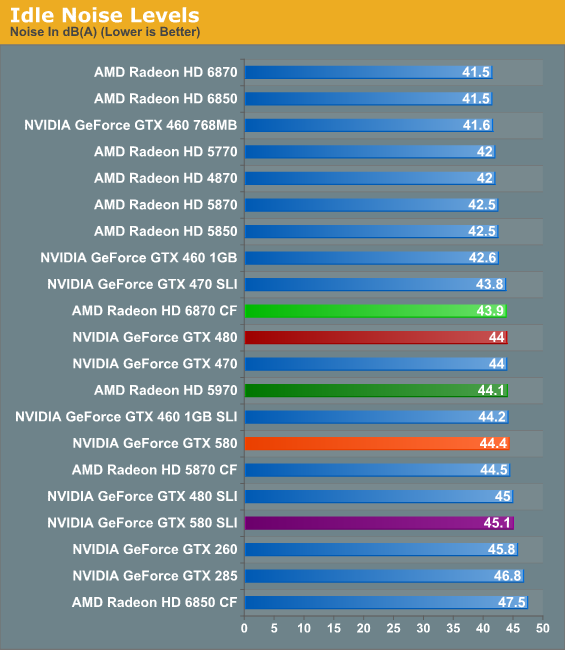
Remember where we said there was a small price to pay for such low idle temperatures? This is it. At 44.4dB, the 580 is ever so slightly (and we do mean slightly) louder than the GTX 480; it also ends up being a bit louder than the 5970 or 6870CF. 44.4 is not by any means loud, but if you want a card that’s whisper silent at idle, the GTX 580 isn’t going to be able to deliver.
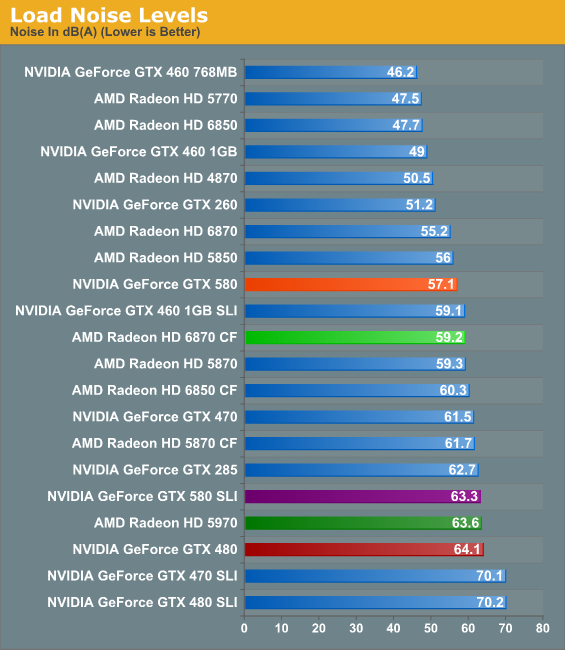
And last but not least is load noise. Between their improvements to power consumption and to cooling, NVIDIA put a lot of effort in to the amount of noise the GTX 580 generates. Where the GTX 480 set new records for a single GPU card, the GTX 580 is quieter than the GTX 285, the GTX 470, and even the Radeon HD 5870. In fact it’s only a dB off of the 5850, a card under most circumstances we’d call the epitome of balance between performance and noise. Graphs alone cannot demonstrate just how much of a difference there is between the GTX 480 and GTX 580 – the GTX 580 is not whisper quiet, but at no point in our testing did it ever get “loud”. It’s a truly remarkable difference; albeit one that comes at the price of pointing out just how lousy the GTX 480 was.
Often the mark of a good card is a balance between power, temperature, and noise, and NVIDIA seems to have finally found their mark. As the GTX 580 is a high end card the power consumption is still high, but it’s no longer the abnormality that was the GTX 480. Meanwhile GPU temperatures have left our self-proclaimed danger zone, and yet at the same time the GTX 580 has become a much quieter card under load than the GTX 480. If you had asked us in what NVIDIA needed to work on with the GTX 480, we would have said noise, temperature, and power consumption in that order; the GTX 580 delivers on just what we would have wanted.










160 Comments
View All Comments
chizow - Tuesday, November 9, 2010 - link
There's 2 ways they can go with the GTX 570, either more disabled SM than just 1 (2-3) and similar clockspeed to the GTX 580, or fewer disabled SM but much lower clockspeed. Both would help to reduce TDP but with more disabled SM that would also help Nvidia unload the rest of their chip yield. I have a feeling they'll disable 2-3 SM with higher clocks similar to the 580 so that the 470 is still slightly slower than the 480.I'm thinking along the same lines as you though for the GTX 560, it'll most likely be the full-fledged GF104 we've been waiting for with all 384SP enabled, probably slightly higher clockspeeds and not much more than that, but definitely a faster card than the original GF104.
vectorm12 - Tuesday, November 9, 2010 - link
I'd really love to see the raw crunching power of the 480/580 vs. 5870/6870.I've found ighashgpu to be a great too to determine that and it can be found at http://www.golubev.com/
Please consider it for future tests as it's very well optimized for both CUDA and Stream
spigzone - Tuesday, November 9, 2010 - link
The performance advantage of a single GPU vs CF or SLI is steadily diminishing and approaching a point of near irrelevancy.6870 CF beats out the 580 in nearly every parameter, often substantially on performance benchmarks, and per current newegg prices, comes in at $80 cheaper.
But I think the real sweet spot would be a 6850 CF setup with AMD Overdrive applied 850Mz clocks, which any 6850 can achieve at stock voltages with minimal thermal/power/noise costs (and minimal 'tinkering'), and from the few 6850 CF benchmarks that showed up would match or even beat the GTX580 on most game benchmarks and come in at $200 CHEAPER.
That's an elbow from the sky in my book.
smookyolo - Tuesday, November 9, 2010 - link
You seem to be forgetting the minimum framerates... those are so much more important than average/maximum.Sihastru - Tuesday, November 9, 2010 - link
Agreed, CF scales very badly when it comes to minumum framerates. It is even below the minimum framerates of one of the cards in the CF setup. It is very anoying when you're doing 120FPS in a game and from time to time your framerates drop to an unplayable and very noticable 20FPS.chizow - Tuesday, November 9, 2010 - link
Nice job on the review as usual Ryan,Would've liked to have seen some expanded results however, but somewhat understandable given your limited access to hardware atm. It sounds like you plan on having some SLI results soon.
I would've really liked to have seen clock-for-clock comparisons though to the original GTX 480 though to isolate the impact of the refinements between GF100 and GF110. To be honest, taking away the ~10% difference in clockspeeds, what we're left with seems to be ~6-10% from those missing 6% functional units (32 SM and 4 TMUs).
I would've also liked to have seen some preliminary overclocking results with the GF110 to see how much the chip revision and cooling refinements increased clockspeed overhead, if at all. Contrary to somewhat popular belief, the GTX 480 did overclock quite well, and while that also increased heat and noise it'll be hard for someone with an overclocked 480 to trade it in for a 580 if it doesn't clock much better than the 480.
I know you typically have follow-up articles once the board partners send you more samples, so hopefully you consider these aspects in your next review, thanks!
PS: On page 4, I believe this should be a supposed GTX 570 mentioned in this excerpt and not GTX 470: "At 244W TDP the card draws too much for 6+6, but you can count on an eventual GTX 470 to fill that niche."
mapesdhs - Tuesday, November 9, 2010 - link
"I would've also liked to have seen some preliminary overclocking results ..."
Though obviously not a true oc'ing revelation, I note with interest there's already
a factory oc'd 580 listed on seller sites (Palit Sonic), with an 835 core and 1670
shader. The pricing is peculiar though, with one site pricing it the same as most
reference cards, another site pricing it 30 UKP higher. Of course though, none
of them show it as being in stock yet. :D
Anyway, thanks for the writeup! At least the competition for the consumer finally
looks to be entering a more sensible phase, though it's a shame the naming
schemes are probably going to fool some buyers.
Ian.
Ryan Smith - Wednesday, November 10, 2010 - link
You're going to have to wait until I have some more cards for some meaningful overclocking results. However clock-for-clock comparisons I can do.http://www.anandtech.com/show/4012/nvidias-geforce...
JimmiG - Tuesday, November 9, 2010 - link
Well technically, this is not a 512-SP card at 772 MHz. This is because if you ever find a way to put all 512 processors at 100% load, the throttling mechanism will kick in.That's like saying you managed to overclock your CPU to 4.7 GHz.. sure, it might POST, but as soon as you try to *do* anything, it instantly crashes.
Ryan Smith - Tuesday, November 9, 2010 - link
Based on the performance of a number of games and compute applications, I am confident that power throttling is not kicking in for anything besides FurMark and OCCT.